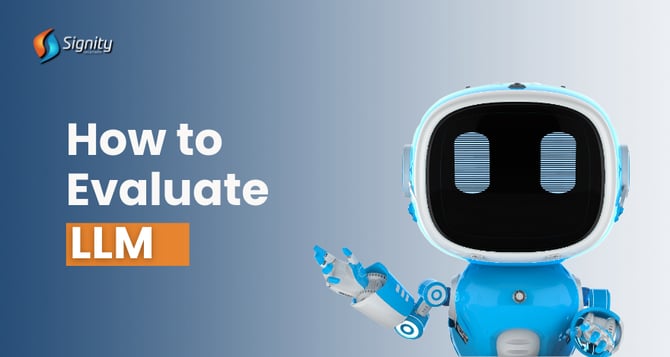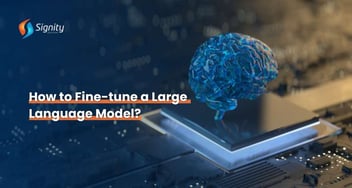How To Evaluate Large Language Models
Having trouble determining if an LLM is truly effective? This blog post clears up the confusion and delves into the realm of LLM evaluation. We'll examine the main challenges of measuring LLM performance, from bias to selecting the appropriate metrics. However, don't worry! We'll also provide you with best practices and upcoming techniques to guarantee that your LLM evaluations are transparent, dependable, and prepared for the future.

Super-powered LLMs like GPT-4, Claude, Gemini, and LLama have revolutionized Natural Language Processing (NLP) in recent years. They enable a wide range of applications across diverse industries. However, sometimes these LLMs, despite their brilliance, can fabricate stories that sound real but aren't entirely true. This is why it's crucial for everyone using LLMs to do so safely and responsibly.
So, how can we ensure that these intelligent language models provide us with the best results? This is where the LLM evaluation comes in! It's like giving your LLM a report card, checking not only its speed but also its accuracy and helpfulness.
Before we delve into evaluation, how are these LLMs even built? If you're curious about the inner workings of LLMs and want to understand how they learn and process information, check out: How to Build Your Own Large Language Models.
What is the LLM Evaluation Framework and Why Does it Matter?
The LLM evaluation framework is a structured approach to assessing the performance of large language models (LLMs) for various tasks. It's like a roadmap that guides you in ensuring your chosen LLM truly delivers the promised benefits.
Here's why LLM evaluation frameworks matter for businesses and industries:
a) Increased Trust and Reliability:
Businesses rely on LLMs for critical tasks like content generation, customer service chatbots, or even data analysis. Evaluation helps identify potential biases, factual inaccuracies, or inconsistencies that could lead to misleading results. This ensures you can trust the information and outputs generated by the LLM.
b) Boosting Performance and ROI:
Evaluation isn't just about identifying flaws; it also helps pinpoint areas where LLMs excel. This knowledge allows businesses to fine-tune the models, adjust training data, or optimize workflows, ultimately leading to better performance and a maximized return on investment (ROI).
c) Making Informed Decisions:
With the LLM landscape constantly evolving, choosing the right model can be overwhelming. Evaluation frameworks provide a standardized approach to comparing different LLMs, highlighting their strengths and weaknesses relative to each other. This enables businesses to make informed decisions and select the LLM that best fits their specific needs.
d) Understanding Real-World Applicability:
Evaluation goes beyond theoretical benchmarks. By incorporating real-world testing and user studies, businesses can assess how LLMs perform in actual use cases. This ensures the model isn't just good at replicating training data but can translate that skill into practical benefits.
e) Mitigating Risk and Ensuring Fairness:
LLMs trained on biased data can perpetuate those biases in their outputs. Evaluation frameworks help identify and address these biases, mitigating risks associated with discriminatory or offensive outputs.
In evaluating complex systems like LLMs and ensuring they meet specific standards for reliability, it's crucial to analyze data observability as well. Understanding parallels of evaluation frameworks for LLMs and how they might intersect with best data observability tools could offer invaluable insights into building comprehensive metrics assessments.
LLM evaluation frameworks are crucial for businesses across industries:
- Media & Marketing: Ensure content generation is factually accurate and avoids bias.
- Customer Service: Guarantee chatbots deliver helpful and informative responses.
- Finance & Law: Verify the accuracy and reliability of data analysis and reporting.
- Healthcare: Maintain the integrity of medical information and communication.
- Education: Promote fair and unbiased learning tools and resources.
By adopting a robust LLM evaluation framework, businesses can harness LLMs' full potential while minimizing risks and ensuring responsible AI implementation.
The good news is that building and implementing effective LLMs doesn't have to be overwhelming. For businesses looking to harness the power of LLMs, partnering with an experienced AI development company can be a game-changer.
Key Concepts in LLM Evaluation
We've discussed why evaluating LLMs is important, but what exactly are we measuring? Let's examine some key concepts in LLM evaluation.
Imagine you ask your LLM assistant to write a summary of a news article. In your head, you have the perfect, concise summary; that's the ground truth. The LLM's summary is its predicted output. LLM evaluation helps us see how close the LLM's summary comes to the real deal.
To quantify the LLM's performance, the below metrics should be kept in mind:
Accuracy Metrics: We utilize specific metrics to evaluate how closely the LLM's response aligns with the correct answer.
For instance, instead of remembering terms like BLEU score or ROUGE score, simply understand that these metrics measure the proximity of the response.
Fluency and Coherence Metrics: It helps ensure that the generated text is not only factually accurate but also grammatically sound, well-structured, and easy to comprehend.
Examples:
The metrics, like Perplexity and Grammaticality, assess the overall quality and readability of the LLM's output.
Human language metrics: It involve real people assessing the LLM's outputs. This might involve experts reviewing generated text for factual accuracy or clarity, or user studies where participants interact with the LLM and provide feedback on its helpfulness and overall quality.
By using these simple ideas, we can understand how LLMs are evaluated and make sure they're giving us the best possible results!
Checking the LLM's Work
We talked about why evaluating LLMs is important, but how do we actually do it? There are a few ways to check their work:
a) Offline Evaluation:
This is like giving the LLM a practice test with pre-made questions and answer sheets (benchmark datasets). We use special tools (automated metrics) to score their answers and see how well they do.
b) Online Evaluation:
It involves experts reviewing generated text for factual accuracy or clarity or user studies in which participants interact with the LLM and provide feedback on its helpfulness and overall quality.
Important Note: Sometimes, we evaluate just the core LLM engine itself (model evaluation), but other times, we assess the entire system, including the user interface and how it works together (system evaluation). It's like checking the engine of a car vs. test-driving the whole car!
5 Benchmarking Steps to Better Evaluate LLM Performance
Let's ditch the intro and jump right into the key LLM benchmarks used to assess these powerful language models!
1.) Benchmark Selection:
To achieve a comprehensive evaluation of a language model’s performance, it is often necessary to employ a combination of benchmarks. The datasets for benchmarks include:
- GLUE: Tests how well LLMs understand language across various tasks (sentiment, similarity, etc.) like humans.
- MMLU: Tests how deeply LLMs understand a wide range of subjects (history, law, etc.) and their reasoning skills.
- AlpacaEval: Tests how well LLMs follow user instructions for complex tasks.
- HELM: Provides a transparent evaluation of LLMs by testing accuracy, fairness, bias, and more across different scenarios.
2.) Dataset Preparation:
High-quality, unbiased datasets are built to train, test, and validate the LLM on specific tasks.
3.) Model Training:
LLMs are trained on massive text datasets (like Wikipedia) and then fine-tuned on specific benchmark tasks.
4.) Evaluation:
Trained models are tested using benchmarks to determine their performance (accuracy, coherence, etc.).
5.) Comparative Analysis:
The results compare different LLMs to identify strengths, weaknesses, and the current best models for specific tasks.
Finding Your Perfect LLM Partner: Why Signity Stands Out
In the exciting world of Large Language Models (LLMs), choosing the right LLM development company is crucial. Signity can be your ideal partner for several reasons:
LLM Expertise: Signity boasts a team of seasoned LLM developers who understand the nuances of these powerful language tools. They stay at the forefront of LLM research and development, ensuring your project leverages the latest advancements.
Tailored Solutions: Signity doesn't offer a one-size-fits-all approach. They work closely with you to understand your specific needs and goals. Whether you need an LLM for creative writing, complex data analysis, or chatbots, Signity customizes a solution that delivers real-world value.
Focus on Explainability & Transparency: Signity understands the importance of trust in LLMs. They prioritize explainability and transparency in their development process, allowing you to understand how your LLM arrives at its outputs and fostering responsible use.
Proven Track Record: Signity has a successful history of delivering impactful LLM solutions across various industries. By partnering with them, you gain access to their experience and expertise, increasing your project's chance of success.
Ready to unlock the potential of LLMs? Let Signity be your guide.













